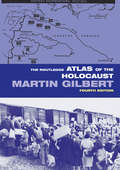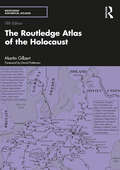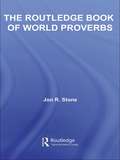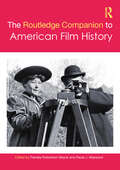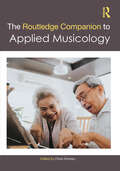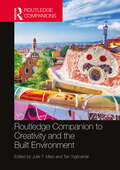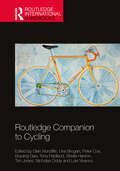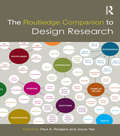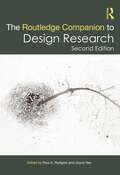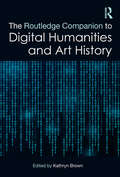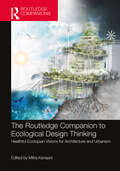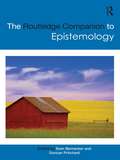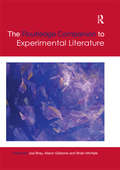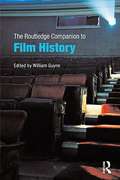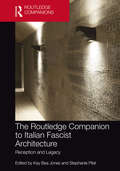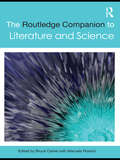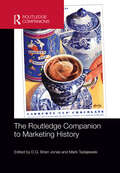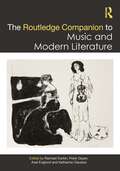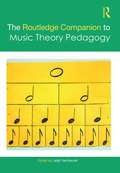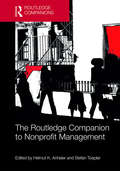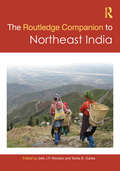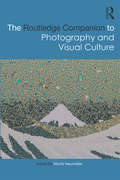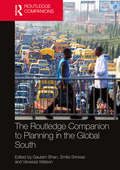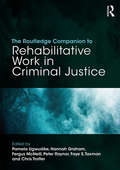- Table View
- List View
The Routledge Atlas of the Holocaust: The Complete History (Routledge Historical Atlases)
by Martin GilbertThe graphic history of the Nazi attempt to destroy the Jews of Europe during the Second World War is illustrated in this series of 333 detailed maps. The maps, and the text and photographs that accompany them, powerfully depict the fate of the Jews between 1933 and 1945, while also setting the chronological story in the wider context of the war itself. The maps include: historical background – from the effects of anti-Jewish violence between 1880 and 1933 to the geography of the existing Jewish communities before the advent of the Nazis the beginning of the violence – from the destruction of the synagogues in November 1938 to Jewish migrations and deportations, the ghettos, and the establishment of the concentration camps and death camps throughout German-dominated Europe the spread of Nazi rule – the fate of the Jews throughout Europe including Germany, Austria, Poland, Greece, Yugoslavia, Bulgaria, Russia, Denmark, Norway, France, Holland, Belgium, Italy, and the Baltic States Jewish revolts and resistance – acts of armed resistance, fighting in the forests, individual acts of courage Jews in hiding – escape routes, Christians who helped Jews the death marches – the advance of the Allies and the liberation of the camps, the survivors, and the final death toll. This revised edition includes a new section which gives an insight into the layout and organization of some of the most significant places of the Holocaust, including Auschwitz, Treblinka and the Warsaw ghetto, maps that will be especially useful to those visiting the sites.
The Routledge Atlas of the Holocaust (Routledge Historical Atlases)
by Martin GilbertThe graphic history of the Nazi attempt to destroy the Jews of Europe during the Second World War is illustrated in this series of 363 detailed maps. The maps, and the text and photographs that accompany them, powerfully depict the fate of the Jews between 1933 and 1945, while also setting the chronological story in the wider context of the war itself. The maps include: • Historical background – from the effects of anti-Jewish violence between 1880 and 1933 to the geography of the existing Jewish communities when the Nazi Party came to power • The beginning of the violence – from the destruction of the synagogues in November 1938 to Jewish migrations and deportations, the ghettos, and the establishment of the concentration camps and death camps throughout German-dominated Europe • The spread of Nazi rule – the fate of the Jews throughout Europe including Germany, Austria, Poland, Greece, Yugoslavia, Bulgaria, Russia, Denmark, Norway, France, Holland, Belgium, Italy, and the Baltic States • Jewish revolts and resistance – acts of armed resistance, fighting in the forests, individual acts of courage • Jews in hiding – escape routes, Christians who helped Jews • The death marches – the advance of the Allies and the liberation of the camps, the survivors, and the final death toll. This new edition now includes an additional 30 of Martin Gilbert’s maps, with many additional camp and ghetto maps, further illustrating the layout and organization of some of the most significant towns and cities affected by the Holocaust, especially useful to those visiting the sites.
The Routledge Book of World Proverbs
by Jon R. StoneThe Routledge Book of World Proverbs invites the reader to travel the globe in search of the origins of such words of wisdom, experiencing the rich cultural traditions reflected in each nation’s proverbs. This collection contains over 16,000 gems of humour and pathos that draw upon themes from our shared experiences of life. And we are not just invited to learn about other cultures; proverbs are ‘bits of ancient wisdom’ and thus teach us about our own history. Drawing together proverbs that transcend culture, time and space to provide a collection that is both useful and enjoyable, The Routledge Book of World Proverbs is, unquestionably, a book of enduring interest.
The Routledge Companion to American Film History (Routledge Media and Cultural Studies Companions)
by Paula J. MassoodPresenting new and diverse scholarship, this collection brings together original essays that explore American film history from a fresh perspective.Comprising an introduction and 34 chapters written by leading scholars from around the globe, and edited by Pamela Robertson Wojcik and Paula J. Massood, this collection offers discussions of the American film industry from previously unexplored vantage points. Rather than follow a chronological format, as with most film histories, this Companion offers a multiplicity of approaches to historiography and is arranged according to often underdeveloped or overlooked areas in American film, including topics such as alternate archives, hidden labor, histories of style, racialized technologies, cinema’s material cultures, spectators and fans, transnational film production, intermedial histories, history in and about films, and the historical afterlives of cinema.An exciting collection for serious film studies students and scholars interested in new perspectives and fresh approaches to thinking about and doing American film history.
The Routledge Companion to Applied Musicology (Routledge Music Companions)
by Chris DromeyThe Routledge Companion to Applied Musicology brings together academics, artist-researchers, and practitioners to provide readers with an extensive and authoritative overview of applied musicology. Once a field that addressed music’s socio-political or performative contexts, applied musicology today encompasses study and practice in areas as diverse as psychology, ecomusicology, organology, forensic musicology, music therapy, health and well-being, and other public-oriented musicologies. These rapid advances have created a fast-changing field whose scholarship and activities tend to take place in isolation from each other. This volume addresses that shortcoming, bringing together a wide-ranging survey of current approaches. Featuring 39 authors, The Routledge Companion to Applied Musicology falls into five parts—Defining and Theorising Applied Musicology; Public Engagement; New Approaches and Research Methods; Representation and Inclusion; and Musicology in/for Performance—that chronicle the subject’s rich history and consider the connections that will characterise its future. The book offers an essential resource for anyone exploring applied musicology.
Routledge Companion to Creativity and the Built Environment (Routledge International Handbooks)
by Julie T. Miao Tan YigitcanlarThis book crtitically examines the reciprocal relationship between creativity and the built environment and features leading voices from across the world in a debate on originating, learning, modifying, and plagiarizing creativities within the built environment.The Companion includes contributions from architecture, design, planning, construction, real estate, economics, urban studies, geography, sociology, and public policies. Contributors review the current field and proposes new conceptual frameworks, research methodologies, and directions for research, policy, and practice. Chapters are organised into five sections, each drawing on cross-disciplinary insights and debates: Section I connects creativity, productivity, and economic growth and examines how our built environment stimulates or intimidates human imaginations. Section II addresses how hard environments are fabricated with social, cultural, and institutional meanings, and how these evolve in different times and settings. Section III discusses activities that directly and indirectly shape the material development of a built environment, its environmental sustainability, space utility, and place identity. Section IV illustrates how technologies and innovations are used in building and strengthening an intelligent, real-time, responsive urban agenda. Section V examines governance opportunities and challenges at the interface between creativity and built environment. An important resource for scholars and students in the fields of urban planning and development, urban studies, environmental sustainability, human geography, sociology, and public policy.
Routledge Companion to Cycling (Routledge International Handbooks)
by Glen Norcliffe Una Brogan Peter Cox Boyang Gao Tony Hadland Sheila Hanlon Tim Jones Nicholas Oddy Luis VivancoRoutledge Companion to Cycling presents a comprehensive overview of an artefact that throughout the modern era has been a bellwether indicator of the major social, economic and environmental trends that have permeated society The volume synthesizes a rapidly growing body of research on the bicycle, its past and present uses, its technological evolution, its use in diverse geographical settings, its aesthetics and its deployment in art and literature. From its origins in early modern carriage technology in Germany, it has generated what is now a vast, multi-disciplinary literature encompassing a wide range of issues in countries throughout the world.
The Routledge Companion to Design Research (Routledge Art History and Visual Studies Companions)
by Paul A. Rodgers and Joyce YeeThe Routledge Companion to Design Research offers a comprehensive examination of design research, celebrating the plurality of design research and the wide range of conceptual, methodological, technological and theoretical approaches evident in contemporary design research. This volume comprises 39 original and high quality design research chapters from contributors around the world, with offerings from the vast array of disciplines in and around modern design praxis, including areas such as industrial and product design, visual communication, interaction design, fashion design, service design, engineering and architecture. The Companion is divided into five distinct sections with chapters that examine the nature and process of design research, the purpose of design research, and how one might embark on design research. They also explore how leading design researchers conduct their design research through formulating and asking questions in novel ways, and the creative methods and tools they use to collect and analyse data. The Companion also includes a number of case studies that illustrate how one might best communicate and disseminate design research through contributions that offer techniques for writing and publicising research. The Routledge Companion to Design Research will have wide appeal to researchers and educators in design and design-related disciplines such as engineering, business, marketing, computing, and will make an invaluable contribution to state-of-the-art design research at postgraduate, doctoral, and post-doctoral levels and teaching across a wide range of different disciplines.
The Routledge Companion to Design Research (Routledge Art History and Visual Studies Companions)
by Paul A. Rodgers Joyce YeeThis new edition of The Routledge Companion to Design Research offers an updated, comprehensive examination of design research, celebrating a plurality of voices and range of conceptual, methodological, technological and theoretical approaches evident in contemporary design research. This volume comprises thirty-eight original and high-quality design research chapters from contributors around the world, with offerings from the vast array of disciplines in and around modern design praxis, including areas such as industrial and product design, visual communication, interaction design, fashion design, service design, engineering and architecture. The Companion is divided into four distinct sections with chapters that examine the nature and process of design research, the purpose of design research and how one might embark on design research. They also explore how leading design researchers conduct their design research through formulating and asking questions in novel ways, and the creative methods and tools they use to collect and analyse data. The Companion also includes a number of case studies that illustrate how one might best communicate and disseminate design research through contributions that offer techniques for writing and publicising research. The Routledge Companion to Design Research has a wide appeal to researchers and educators in design and design-related disciplines such as engineering, business, marketing, and computing, and will make an invaluable contribution to state-of-the-art design research at postgraduate, doctoral and post-doctoral levels and teaching across a wide range of different disciplines.
The Routledge Companion to Digital Humanities and Art History (Routledge Art History and Visual Studies Companions)
by Kathryn BrownThe Routledge Companion to Digital Humanities and Art History offers a broad survey of cutting-edge intersections between digital technologies and the study of art history, museum practices, and cultural heritage. The volume focuses not only on new computational tools that have been developed for the study of artworks and their histories but also debates the disciplinary opportunities and challenges that have emerged in response to the use of digital resources and methodologies. Chapters cover a wide range of technical and conceptual themes that define the current state of the field and outline strategies for future development. This book offers a timely perspective on trans-disciplinary developments that are reshaping art historical research, conservation, and teaching. This book will be of interest to scholars in art history, historical theory, method and historiography, and research methods in education.
The Routledge Companion to Ecological Design Thinking: Healthful Ecotopian Visions for Architecture and Urbanism
by Mitra KanaaniThis companion investigates the ways in which designers, architects, and planners address ecology through the built environment by integrating ecological ideas and ecological thinking into discussions of urbanism, society, culture, and design. Exploring the innovation of materials, habitats, landscapes, and infrastructures, it furthers novel ecotopian ideas and ways of living, including human-made settings on water, in outer space, and in extreme environments and climatic conditions. Chapters of this extensive collection on ecotopian design are grouped under five different ecological perspectives: design manifestos and ecological theories, anthropocentric transformative design concepts, design connectivity, climatic design, and social design. Contributors provide plausible, sustainable design ideas that promote resiliency, health, and well-being for all living things, while taking our changing lifestyles into consideration. This volume encourages creative thinking in the face of ongoing environmental damage, with a view to making design decisions in the interest of the planet and its inhabitants. With contributions from over 79 expert practitioners, educators, scientists, researchers, and theoreticians, as well as planners, architects, and engineers from the U.S., Canada, Europe, and Asia, this book engages theory, history, technology, engineering, and science, as well as the human aspects of ecotopian design thinking and its implications for the outlook of the planet.
The Routledge Companion to Embodied Music Interaction (Routledge Music Companions)
by Marc Leman Micheline Lesaffre Pieter-Jan MaesThe Routledge Companion to Embodied Music Interaction captures a new paradigm in the study of music interaction, as a wave of recent research focuses on the role of the human body in musical experiences. This volume brings together a broad collection of work that explores all aspects of this new approach to understanding how we interact with music, addressing the issues that have roused the curiosities of scientists for ages: to understand the complex and multi-faceted way in which music manifests itself not just as sound but also as a variety of cultural styles, not just as experience but also as awareness of that experience. With contributions from an interdisciplinary and international array of scholars, including both empirical and theoretical perspectives, the Companion explores an equally impressive array of topics, including: Dynamical music interaction theories and concepts Expressive gestural interaction Social music interaction Sociological and anthropological approaches Empowering health and well-being Modeling music interaction Music-based interaction technologies and applications This book is a vital resource for anyone seeking to understand human interaction with music from an embodied perspective.
The Routledge Companion to Epistemology (Routledge Philosophy Companions)
by Duncan Pritchard Sven BerneckerEpistemology, the philosophy of knowledge, is at the core of many of the central debates and issues in philosophy, interrogating the notions of truth, objectivity, trust, belief and perception. The Routledge Companion to Epistemology provides a comprehensive and the up-to-date survey of epistemology, charting its history, providing a thorough account of its key thinkers and movements, and addressing enduring questions and contemporary research in the field. Organized thematically, the Companion is divided into ten sections: Foundational Issues, The Analysis of Knowledge, The Structure of Knowledge, Kinds of Knowledge, Skepticism, Responses to Skepticism, Knowledge and Knowledge Attributions, Formal Epistemology, The History of Epistemology, and Metaepistemological Issues. Seventy-eight chapters, each between 5000 and 7000 words and written by the world’s leading epistemologists, provide students with an outstanding and accessible guide to the field. Designed to fit the most comprehensive syllabus in the discipline, this text will be an indispensible resource for anyone interested in this central area of philosophy. The Routledge Companion to Epistemology is essential reading for students of philosophy.
The Routledge Companion to Experimental Literature (Routledge Literature Companions)
by Joe Bray Alison Gibbons Brian McHaleWhat is experimental literature? How has experimentation affected the course of literary history, and how is it shaping literary expression today? Literary experiment has always been diverse and challenging, but never more so than in our age of digital media and social networking, when the very category of the literary is coming under intense pressure. How will literature reconfigure itself in the future? The Routledge Companion to Experimental Literature maps this expansive and multifaceted field, with essays on: the history of literary experiment from the beginning of the twentieth century to the present the impact of new media on literature, including multimodal literature, digital fiction and code poetry the development of experimental genres from graphic narratives and found poetry through to gaming and interactive fiction experimental movements from Futurism and Surrealism to Postmodernism, Avant-Pop and Flarf. Shedding new light on often critically neglected terrain, the contributors introduce this vibrant area, define its current state, and offer exciting new perspectives on its future. This volume is the ideal introduction for those approaching the study of experimental literature for the first time or looking to further their knowledge.
The Routledge Companion to Film History
by William GuynnThe Routledge Companion to Film History is an indispensible guide for anyone studying film history for the first time. Incorporating a series of 11 introductory, critical essays on key subject areas, with a dictionary of key names and terms, it serves to introduce the reader to the field of film history in a comprehensive and well-rounded manner.
The Routledge Companion to Italian Fascist Architecture: Reception and Legacy
by Kay Bea Jones Stephanie PilatToday, nearly a century after the National Fascist Party came to power in Italy, questions about the built legacy of the regime provoke polemics among architects and scholars. Mussolini’s government constructed thousands of new buildings across the Italian Peninsula and islands and in colonial territories. From hospitals, post offices and stadia to housing, summer camps, Fascist Party Headquarters, ceremonial spaces, roads, railways and bridges, the physical traces of the regime have a presence in nearly every Italian town. The Routledge Companion to Italian Fascist Architecture investigates what has become of the architectural and urban projects of Italian fascism, how sites have been transformed or adapted and what constitutes the meaning of these buildings and cities today. The essays include a rich array of new arguments by both senior and early career scholars from Italy and beyond. They examine the reception of fascist architecture through studies of destruction and adaptation, debates over reuse, artistic interventions and even routine daily practices, which may slowly alter collective understandings of such places. Paolo Portoghesi sheds light on the subject from his internal perspective, while Harald Bodenschatz situates Italy among period totalitarian authorities and their symbols across Europe. Section editors frame, synthesize and moderate essays that explore fascism’s afterlife; how the physical legacy of the regime has been altered and preserved and what it means now. This critical history of interpretations of fascist-era architecture and urban projects broadens our understanding of the relationships among politics, identity, memory and place. This companion will be of interest to students and scholars in a range of fields, including Italian history, architectural history, cultural studies, visual sociology, political science and art history.
The Routledge Companion to Literature and Science (Routledge Literature Companions)
by Bruce ClarkeWith forty-four newly commissioned articles from an international cast of leading scholars, The Routledge Companion to Literature and Science traces the network of connections among literature, science, technology, mathematics, and medicine. Divided into three main sections, this volume: links diverse literatures to scientific disciplines from Artificial Intelligence to Thermodynamics surveys current theoretical and disciplinary approaches from Animal Studies to Semiotics traces the history and culture of literature and science from Greece and Rome to Postmodernism. Ranging from classical origins and modern revolutions to current developments in cultural science studies and the posthumanities, this indispensible volume offers a comprehensive resource for undergraduates, postgraduates, and researchers. With authoritative, accessible, and succinct treatments of the sciences in their literary dimensions and cultural frameworks, here is the essential guide to this vibrant area of study.
The Routledge Companion to Marketing History (Routledge Companions in Business, Management and Accounting)
by Mark Tadajewski D.G. Brian JonesThe Routledge Companion to Marketing History is the first collection of readings that surveys the broader field of marketing history, including the key activities and practices in the marketing process. With contributors from leading international scholars working in marketing history, this companion provides nine country-specific histories of marketing practice as well as a broad analysis of the field, including: the histories of advertising, retailing, channels of distribution, product design and branding, pricing strategies, and consumption behavior. While other collections have provided an overview of the history of marketing thought, this is the first of its kind to do so from the perspective of companies, industries, and even whole economies. The Routledge Companion to Marketing History ranges across many countries and industries, engaging in substantive detail with marketing practices as they were performed in a variety of historical periods extending back to ancient times. It is not to be missed by any historian or student of business.
The Routledge Companion to Music and Modern Literature (Routledge Music Companions)
by Rachael DurkinModern literature has always been obsessed by music. It cannot seem to think about itself without obsessing about music. And music has returned the favour. The Routledge Companion to Music and Modern Literature addresses this relationship as a significant contribution to the burgeoning field of word and music studies. The 37 chapters within consider the partnership through four lenses—the universal, opera and literature, musical and literary forms, and popular music and literature—and touch upon diverse and pertinent themes for our modern times, ranging from misogyny to queerness, racial inequality to the claimed universality of whiteness. This Companion therefore offers an essential resource for all who try to decode the musico-literary exchange.
The Routledge Companion to Music Theory Pedagogy (Routledge Music Companions)
by Leigh VanHandelToday’s music theory instructors face a changing environment, one where the traditional lecture format is in decline. The Routledge Companion to Music Theory Pedagogy addresses this change head-on, featuring battle-tested lesson plans alongside theoretical discussions of music theory curriculum and course design. With the modern student in mind, scholars are developing creative new approaches to teaching music theory, encouraging active student participation within contemporary contexts such as flipped classrooms, music industry programs, and popular music studies. This volume takes a unique approach to provide resources for both the conceptual and pragmatic sides of music theory pedagogy. Each section includes thematic "anchor" chapters that address key issues, accompanied by short "topics" chapters offering applied examples that instructors can readily adopt in their own teaching. In eight parts, leading pedagogues from across North America explore how to most effectively teach the core elements of the music theory curriculum: Fundamentals Rhythm and Meter Core Curriculum Aural Skills Post-Tonal Theory Form Popular Music Who, What, and How We Teach A broad musical repertoire demonstrates formal principles that transcend the Western canon, catering to a diverse student body with diverse musical goals. Reflecting growing interest in the field, and with an emphasis on easy implementation, The Routledge Companion to Music Theory Pedagogy presents strategies and challenges to illustrate and inspire, in a comprehensive resource for all teachers of music theory.
The Routledge Companion to Nonprofit Management (Routledge Companions in Business and Management)
by Helmut K. Anheier;Stefan ToeplerOver the past three decades or so, the nonprofit, voluntary, or third sector has undergone a major transformation from a small cottage industry to a major economic force in virtually every part of the developed world as well as elsewhere around the globe. Nonprofit organizations are now major providers of public services working in close cooperation with governments at all levels and increasingly find themselves in competition with commercial firms across various social marketplaces. This transformation has come with ever-increasing demands for enhancing the organizational capacities and professionalizing the management of nonprofit institutions. The Routledge Companion to Nonprofit Management is the first internationally focused effort to capture the full breadth of current nonprofit management research and knowledge that has arisen in response to these developments. With newly commissioned contributions from an international set of scholars at the forefront of nonprofit management research, this volume provides a thorough overview of the most current management thinking in this field. It contextualizes nonprofit management globally, provides an extensive introduction to key management functions, core revenue sources and the emerging social enterprise space, and raises a number of emerging topics and issues that will shape nonprofit management in future decades. As graduate programs continue to evolve to serve the training needs in the field, The Routledge Companion to Nonprofit Management is an essential reference and resource for graduate students, researchers, and practitioners interested in a deeper understanding of the operation of the nonprofit sector.
The Routledge Companion to Northeast India
by Jelle J.P. Wouters and Tanka B. SubbaThe Routledge Companion to Northeast India is a trans-disciplinary and comprehensive compendium of a vital yet under-researched region in South Asia. It provides a unique guide to prevailing themes, theories, arguments, and history of Northeast India by discussing its life-forms – human and not – languages, landscapes, and lifeways in all its diversity and difference. The companion contains authoritative entries from leading specialists from and on the region and offers clear, concise, and illuminating explanations of key themes and ideas. A hands-on, practical, and comprehensive guide to Northeast India, this companion fills a significant gap in the literature and will be an invaluable teaching, learning, and research resource for scholars and students of Northeast India Studies, South Asian and Southeast Asian societies, culture, politics, humanities, and the social sciences in general.
The Routledge Companion to Photography and Visual Culture (Routledge Art History and Visual Studies Companions)
by Moritz NeumüllerThe Routledge Companion to Photography and Visual Culture is a seminal reference source for the ever-changing field of photography. Comprising an impressive range of essays and interviews by experts and scholars from across the globe, this book examines the medium’s history, its central issues and emerging trends, and its much-discussed future. The collected essays and interviews explore the current debates surrounding the photograph as object, art, document, propaganda, truth, selling tool, and universal language; the perception of photography archives as burdens, rather than treasures; the continual technological development reshaping the field; photography as a tool of representation and control, and more. One of the most comprehensive volumes of its kind, this companion is essential reading for photographers and historians alike.
The Routledge Companion to Planning in the Global South (Routledge International Handbooks)
by Gautam Bhan Smita Srinivas Vanessa WatsonThe Routledge Companion to Planning in the Global South offers an edited collection on planning in parts of the world which, more often than not, are unrecognised or unmarked in mainstream planning texts. In doing so, its intention is not to fill a ‘gap’ that leaves this ‘mainstream’ unquestioned but to re-theorise planning from a deep understanding of ‘place’ as well as a commitment to recognise the diverse modes of practice that come within it. The chapters thus take the form not of generalised, ‘universal’ analyses and prescriptions, but instead are critical and located reflections in thinking about how to plan, act and intervene in highly complex city, regional and national contexts. Chapter authors in this Companion are not all planners, or are planners of very different kinds, and this diversity ensures a rich variety of insights, primarily based on cases, to emphasise the complexity of the world in which planning is expected to happen. The book is divided into a framing Introduction followed by five sections: planning and the state; economy and economic actors; new drivers of urban change; landscapes of citizenship; and planning pedagogy. This volume will be of interest to all those wanting to explore the complexities of planning practice and the need for new theories of knowledge from which to draw insight to face the challenges of the 21st century.
The Routledge Companion to Rehabilitative Work in Criminal Justice
by Pamela Ugwudike Hannah Graham Fergus McNeill Peter Raynor Faye S. Taxman Chris TrotterAll the world’s criminal justice systems need to undertake direct work with people who have come into their care or are under their supervision as a result of criminal offences. Typically, this is organized in penal and correctional services – in custody in prisons, or in the community, supervised by services such as probation. Bringing together international experts, this book is the go-to source for students, researchers, and practitioners in criminal justice, looking for a comprehensive and authoritative summary of available knowledge in the field. Covering a variety of contexts, settings, needs, and approaches, and drawing on theory and practice, this Companion brings together over 90 entries, offering readers concise and definitive overviews of a range of key contemporary issues on working with offenders. The book is split into thematic sections and includes coverage of: Theories and models for working with offenders Policy contexts of offender supervision and rehabilitation Direct work with offenders Control, surveillance, and practice Resettlement Application to specific groups, including female offenders, young offenders, families, and ethnic minorities Application to specific needs and contexts, such as substance misuse, mental health, violence, and risk assessment Practitioner and offender perspectives The development of an evidence base This book is an essential and flexible resource for researchers and practitioners alike and is an authoritative guide for students taking courses on working with offenders, criminal justice policy, probation, prisons, penology, and community corrections.
